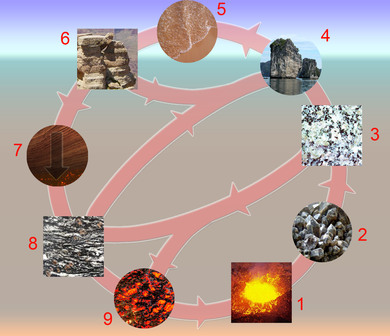4.6: The Rock Cycle
- Page ID
- 12787
 Rocks change as a result of natural processes that are taking place all the time. Most changes happen very slowly; many take place below the Earth’s surface, so we may not even notice the changes. Although we may not see the changes, the physical and chemical properties of rocks are constantly changing in a natural, never-ending cycle called the rock cycle.The concept of the rock cycle was first developed by James Hutton, an eighteenth century scientist often called the “Father of Geology.” Hutton recognized that geologic processes have “no [sign] of a beginning, and no prospect of an end.” The processes involved in the rock cycle often take place over millions of years. So on the scale of a human lifetime, rocks appear to be “rock solid” and unchanging, but in the longer term, change is always taking place.
Rocks change as a result of natural processes that are taking place all the time. Most changes happen very slowly; many take place below the Earth’s surface, so we may not even notice the changes. Although we may not see the changes, the physical and chemical properties of rocks are constantly changing in a natural, never-ending cycle called the rock cycle.The concept of the rock cycle was first developed by James Hutton, an eighteenth century scientist often called the “Father of Geology.” Hutton recognized that geologic processes have “no [sign] of a beginning, and no prospect of an end.” The processes involved in the rock cycle often take place over millions of years. So on the scale of a human lifetime, rocks appear to be “rock solid” and unchanging, but in the longer term, change is always taking place.
In the rock cycle the three main rock types are igneous, sedimentary, and metamorphic. Arrows connecting the three rock types show the processes that change one rock type into another. The cycle has no beginning and no end. Rocks deep within the Earth are right now becoming other types of rocks. Rocks at the surface are lying in place before they are next exposed to a process that will change them.
Several processes can turn one type of rock into another type of rock. The key processes of the rock cycle are crystallization, erosion and sedimentation, and metamorphism.
Crystallization
Magma cools either underground or on the surface and hardens into an igneous rock. As the magma cools, different crystals form at different temperatures, undergoing crystallization. For example, the mineral olivine crystallizes out of magma at much higher temperatures than quartz. The rate of cooling determines how much time the crystals will have to form. Slow cooling produces larger crystals.
Erosion and Sedimentation
Weathering wears rocks at the Earth’s surface down into smaller pieces. The small fragments are called sediments. Running water, ice, and gravity all transport these sediments from one place to another by erosion. During sedimentation, the sediments are laid down or deposited. In order to form a sedimentary rock, the accumulated sediment must become compacted and cemented together.
When a rock is exposed to extreme heat and pressure within the Earth but does not melt, the rock becomes metamorphosed. Metamorphism may change the mineral composition and the texture of the rock. For that reason, a metamorphic rock may have a new mineral composition and/or texture.
- Dynamic Earth: Introduction to Physical Geography. Authored by: R. Adam Dastrup. Located at: http://www.opengeography.org/physical-geography.html. Project: Open Geography Education. License: CC BY-SA: Attribution-ShareAlike
- Rock Cycle. Authored by: Woudloper/Woodwalker. Located at: https://commons.wikimedia.org/wiki/File:Rockcycle.jpg. License: Public Domain: No Known Copyright

